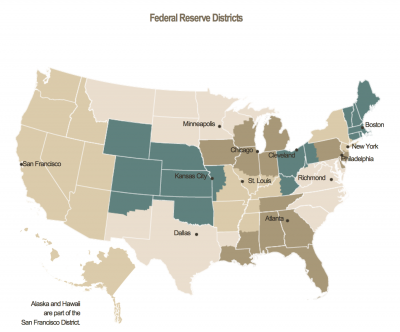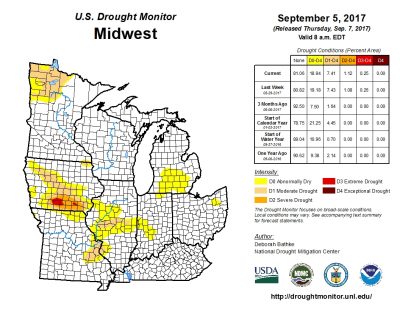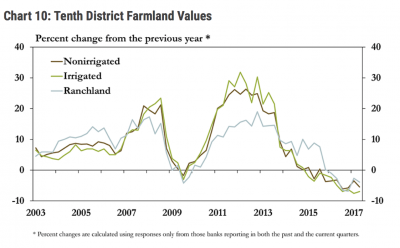Agriculture leaders in the United States House of Representatives are looking to provide at least an additional $10 billion in farmer aid to supplement the recently announced Farmer Bridge Assistance…
Federal Reserve: Observations on the Ag Economy- August ’17
On Wednesday, the Federal Reserve Board released its August 2017 Beige Book update, a summary of commentary on current economic conditions by Federal Reserve District. The report included several observations pertaining to the U.S. agricultural economy.

* Sixth District- Atlanta– “Agriculture conditions across the District were mixed. Significant rainfall throughout much of the District eliminated drought conditions but resulted in many areas experiencing abnormally moist to excessively wet conditions. These heavy or frequent rains caused some crop damage and delayed planting and harvesting in parts of the District. Forecasts still indicate that the District will exceed last year’s production in cotton, soybeans, and peanuts, but lower rice and corn production is expected. With harvesting completed for the current season, Florida’s orange production forecast was significantly lower than last year’s production. On a year-over-year basis, prices paid to farmers in June were up for cotton, beef, broilers, and eggs but were down for corn, rice, and soybeans.”
* Seventh District- Chicago– “A lack of rainfall in July and early August hurt crops in much of Iowa and parts of Illinois and Indiana.”

Crop conditions and maturity lagged that of last year’s bumper crop, to the point that contacts expected the corn harvest to be below trend and the soybean harvest to be at about trend.
“Corn and wheat prices fell, while soybean prices were flat. Given current prices, some operations will be able to make crop insurance claims and take advantage of government support programs.”
The average price received by farmers for #corn during July in Iowa was $3.40; #soybeans, $9.32- @usda_nass pic.twitter.com/EbFSsuoaTf
— Farm Policy (@FarmPolicy) September 6, 2017
“Dairy prices moved higher, reportedly easing losses for dairy operations. Hog and cattle prices were down, but prices were still high enough for many operations to be able to turn a profit. In addition, contacts expected that the opening of a pork processing plant in Michigan would lead to greater demand for hogs in the region.”
* Eighth District- St. Louis– “District agricultural conditions were mixed in this reporting period. The conditions of the District’s cotton and rice crops have improved since our previous report and are better than the same time last year. Although rice conditions have improved, early-season flooding pushed acreage down 25 percent from last year. The lost acreage will hurt rice farmers this year, but some of these farmers are optimistic that a recent trade agreement with China will boost profits. Meanwhile, corn and soybean conditions declined from the previous period.”

* Ninth District- Minneapolis– “District agricultural conditions remained weak overall since the previous report. In spite of recent rains, severe drought conditions persisted in the Dakotas and Montana.


Farmers in many areas were cutting failed cereal crops for hay, while livestock producers were selling off parts of their herds due to a lack of feed.
“Meanwhile, crop conditions remained much better in eastern parts of the District, and sugar beet growers in Minnesota and North Dakota were anticipating a potential record crop.”
* Tenth District- Kansas City– “The District farm economy continued to soften since the previous reporting period, but the pace of the decline slowed somewhat. Crop prices decreased modestly in late July and August due to an increase in production expectations for the year. Livestock prices also declined modestly and some cattle feedlots reported modest losses.
Although District contacts continued to report a decrease in farm income and loan repayment rates, the pace of the decline was slower than in recent periods.
“The continued decline in farm income again pushed farmland values lower, but only slightly, as values also appeared to stabilize in some parts of the District. In general, agricultural credit conditions continued to weaken and were expected to decline further in coming months.”

* Eleventh District- Dallas– “Above-average moisture levels and cooler-than-normal weather boosted crop conditions. Sorghum and corn crop yields were better than average. However, grain prices fell below typical breakeven prices during the reporting period, and contacts noted it will take well- above-average yields to offset the low prices. Cattle prices also trended lower, prompting some financial concerns for ranchers after several months of profitability. Agricultural producers were concerned about the renegotiation of NAFTA, as many rely on export markets to sell their products.”
* Twelfth District- San Francisco– “Activity in the agriculture sector picked up at a modest pace. Harvest yields of grain were strong. Dealers reported that demand for used agricultural equipment picked up, while sales of new equipment were soft.”





